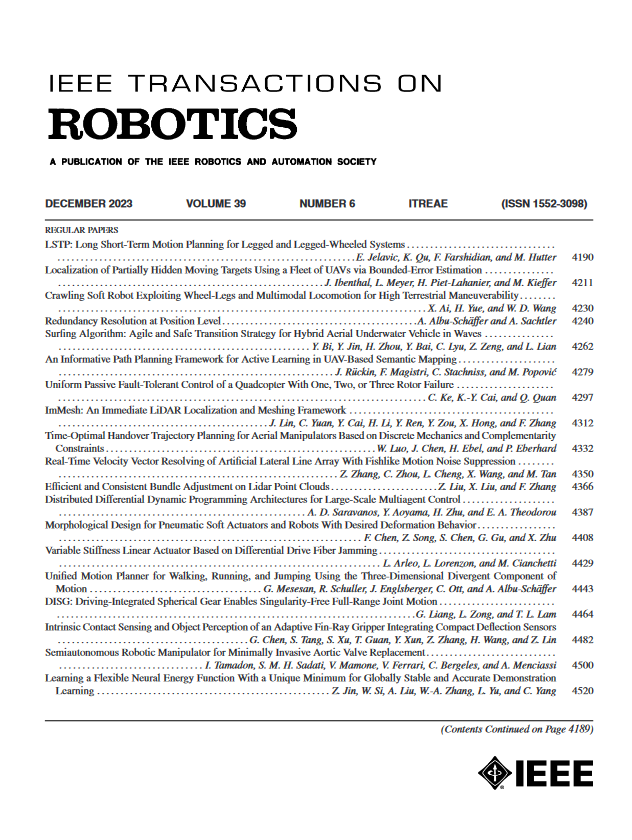LIGO:基于层次融合框架的LiDAR-Inertial-GNSS紧密耦合测距与实时映射
IF 9.4
1区 计算机科学
Q1 ROBOTICS
引用次数: 0
摘要
本文章由计算机程序翻译,如有差异,请以英文原文为准。
LIGO: A Tightly Coupled LiDAR-Inertial-GNSS Odometry Based on a Hierarchy Fusion Framework for Global Localization With Real-Time Mapping
This article introduces a method for tightly fusing sensors with diverse characteristics to maximize their complementary properties, thereby surpassing the performance of individual components. Specifically, we propose a tightly coupled light detection and ranging (LiDAR)-inertial-global navigation satellite system (GNSS) odometry (LIGO) system, which synthesizes the advantages of LiDAR, inertial measurement unit (IMU), and GNSS. Integrating LiDAR with IMU demonstrates remarkable precision and robustness in high-dynamics and high-speed motions. However, LiDAR-Inertial systems encounter limitations in feature-scarce environments or during large-scale movements. GNSS integration overcomes these challenges by providing global and absolute measurements. LIGO employs an innovative hierarchical fusion approach with both front-end and back-end components to achieve synergistic performance. The front-end of LIGO utilizes a tightly coupled, extended Kalman filter (EKF)-based LiDAR-Inertial system for high-bandwidth localization and real-time mapping within a local-world frame. The back-end tightly integrates the filtered LiDAR-Inertial factors from the front-end with GNSS observations in an extensive factor graph, being more robust to outliers and noises in GNSS observations and producing optimized globally referenced state estimates. These optimized back-end results are then fed back to the front-end through the EKF to ensure a drift-free trajectory, particularly in degenerate and large-scale scenarios. Real-world experiments validate the effectiveness of LIGO, especially when applied to aerial vehicles with outlier-prone GNSS data, demonstrating its resilience to signal losses and data quality fluctuations. LIGO outperforms comparable systems, offering enhanced accuracy and reliability across varying conditions.
求助全文
通过发布文献求助,成功后即可免费获取论文全文。
去求助
来源期刊

IEEE Transactions on Robotics
工程技术-机器人学
CiteScore
14.90
自引率
5.10%
发文量
259
审稿时长
6.0 months
期刊介绍:
The IEEE Transactions on Robotics (T-RO) is dedicated to publishing fundamental papers covering all facets of robotics, drawing on interdisciplinary approaches from computer science, control systems, electrical engineering, mathematics, mechanical engineering, and beyond. From industrial applications to service and personal assistants, surgical operations to space, underwater, and remote exploration, robots and intelligent machines play pivotal roles across various domains, including entertainment, safety, search and rescue, military applications, agriculture, and intelligent vehicles.
Special emphasis is placed on intelligent machines and systems designed for unstructured environments, where a significant portion of the environment remains unknown and beyond direct sensing or control.
 求助内容:
求助内容: 应助结果提醒方式:
应助结果提醒方式:


